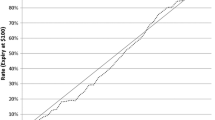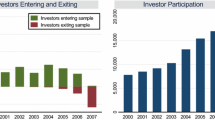Abstract
The number 8 is considered lucky under the Chinese culture. This paper tries to examine whether investors hold such superstitious belief in the Hong Kong Stock Exchange. Using the transaction level data, we first show that more intense net buying occurs at 8-ending lots. Next, we seek favorable evidence in support of financial complexity hypothesis and informed trading hypothesis, both of which are effective in expounding the prevalence of this biased trading behavior. Finally, we find that traders’ learning by means of information acquisition is able to alleviate the lucky-8 effect on superstitious traders.

Similar content being viewed by others
Notes
David Derbyshire, Why `lucky 7’ really is the world’s magic number, http://www.dailymail.co.uk/news/article-2601281/Why-lucky-7-really-magic-number.html, 10 April 2014.
Due to being sourced directly from the leading information system (Bloomberg), the high-frequency data in this paper has a better quality relative to that from the Thomson Reuters Tick History (TRTH).
While price contribution (PC) is the second term specified in Eq. (2), price contribution per trade (PCT) is calculated by adjusting PC with its daily trades of the same-category lot.
The model refers to “Appendix”.
References
Auer B (2015) Superstitious seasonality in precious metals markets? Evidence from GARCH models with time-varying skewness and kurtosis. Appl Econ 47:2844–2859
Barber B, Odean T (2000) Trading is hazardous to your wealth: the common stock investment performance of individual investors. J Finance 55:773–806
Barber B, Odean T (2001) Boys will be boys: gender, overconfidence, and common stock investment. Q J Econ 116:261–292
Barclay M, Hendershott T (2003) Price discovery and trading after hours. Rev Financ Stud 16:1041–1073
Barclay M, Warner J (1993) Stealth trading and volatility: Which trades move prices? J Financ Econ 34:281–305
Bhattacharya U, Holden C, Jacobsen S (2012) Penny wise, dollar foolish: buy-sell imbalances on and around round numbers. Manag Sci 58:413–431
Bhattacharya U, Kuo W, Lin T, Zhao J (2018) Do superstitious traders lose money? Manag Sci 64:3772–3791
Chang C, Chen S, Hsieh S (2017) Asymmetric reinforcement learning and conditioned responses during the 2007–2009 global financial crisis: evidence from Taiwan. Rev Pac Basin Financ Mark Policies 20:1–44
Choi J, Laibson D, Madrian B, Metrick A (2009) Reinforcement learning and savings behavior. J Finance 64:2515–2534
Chung R, Darrat A, Li B (2014) Chinese superstition in US commodity trading. Appl Econ Lett 21:171–175
Da Z, Engelberg J, Gao P (2011) In search of attention. J Finance 66:1461–1499
Drake M, Roulstone D, Thornock J (2012) Investor information demand. J Account Res 50:1001–1040
Fama E, MacBeth J (1973) Risk, return, and equilibrium: empirical tests. J Polit Econ 81:607–636
Fortin N, Hill A, Huang J (2014) Superstition in the housing market. Econ Inq 52:974–993
Glosten L, Harris L (1988) Estimating the component of the bid-ask spread. J Financ Econ 21:123–142
Goodman J, Irwin J (2006) Special random numbers: beyond the illusion of control. Organ Behav Hum Decis Process 99:161–174
Grinblatt M, Keloharju M (2009) Sensation seeking, overconfidence, and trading activity. J Finance 64:549–578
Haggard K (2015) Stock returns in Chinese markets and lucky numbered days. Manag Finance 41:925–939
Hasbrouck J (1991) Measuring the information content of stock trades. J Finance 46:179–207
He J, Liu H, Sing T, Song C, Wong W (2016) Superstition, conspicuous spending, and housing markets: evidence from Singapore. Working Paper, Social Science Research Network
Hirshleifer D (2001) Investor psychology and asset pricing. J Finance 56:1533–1597
Hirshleifer D, Lim S, Teoh S (2009) Driven to distraction: extraneous events and underreaction to earnings news. J Finance 64:2289–2325
Hirshleifer D, Jian M, Zhang H (2018) Superstition and financial decision making. Manag Sci 64:235–252
Humphreys B, Nowak A, Zhou Y (2019) Superstition and real estate prices: transaction-level evidence from the US housing market. Appl Econ. https://doi.org/10.1080/00036846.2018.1558361
Ke W, Chen H, Lin H, Liu Y (2017) The impact of numerical superstition on the final digit of stock price. N Am J Econ Finance 39:145–157
Kong D, Lin C, Liu S (2019) Does information acquisition alleviate market anomalies? Categorization bias in stock splits. Rev Finance 23:245–277
Kumar A (2009a) Who gambles in the stock market? J Finance 64:1889–1933
Kumar A (2009b) Hard-to-value stocks, behavioral biases, and informed trading. J Financ Quant Anal 44:1375–1401
Kuo W, Lin T, Zhao J (2015) Cognitive limitation and investment performance: evidence from limit order clustering. Rev Financ Stud 28:838–875
Levitt S, List J (2007) What do laboratory experiments measuring social preferences reveal about the real world? J Econ Perspect 21:153–174
List J (2003) Does market experience eliminate market anomalies? Q J Econ 118:41–71
List J (2011) Does market experience eliminate market anomalies? The case of exogenous market experience. Am Econ Rev 101:313–317
Massa M, Simonov A (2006) Hedging, familiarity, and portfolio choice. Rev Financ Stud 19:633–685
Massey C, Thaler R (2013) The loser’s curse: decision making and market efficiency in the national football league draft. Manag Sci 59:1479–1495
Meng L, Verousis T, Gwilym O (2013) A substitution effect between price clustering and size clustering in credit default swaps. J Int Financ Mark Inst Money 24:139–153
Mitton T, Vorkink K (2007) Equilibrium underdiversification and the preference for skewness. Rev Financ Stud 20:1255–1288
Ng T, Chong T, Du X (2010) The value of superstitions. J Econ Psychol 31:293–309
Rehm M, Chen S, Filippova O (2018) Prices and superstition among ethnic Chinese and non-Chinese homebuyers in Auckland, New Zealand. Int J Hous Mark Anal 11:34–44
Rosch E (1975) Cognitive reference points. Cogn Psychol 7:532–547
Shefrin H, Statman M (1985) The disposition to sell winners too early and ride losers too long: theory and evidence. J Finance 40:777–790
Shum M, Sun W, Ye G (2014) Superstition and “lucky” apartments: evidence from transaction-level data. J Comp Econ 42:109–117
Wells R (2017) Choice of order size and price discovery: the last digit puzzle. Working Paper, Social Science Research Network
Weng P (2018) Lucky issuance: the role of numerological superstitions in irrational return premiums. Pac Basin Finance J 47:79–91
Wong W, Abdullah N, Lim H (2017) The value of Chinese superstitions in Malaysia: evidence from car plate auctioning. Singap Econ Rev. https://doi.org/10.1142/S0217590817430081
Wright D (2016) Superstitious behavior in financial decision-making. Soc Sci Res Net. https://doi.org/10.2139/ssrn.2811965
Wu W, Gau Y (2017) Home bias in portfolio choices: social learning among partially informed agents. Rev Quant Finance Account 48:527–556
Wu C, Zhang W (2002) Trade disclosure, information learning and securities market performance. Rev Quant Finance Account 18:21–38
Yang Z (2011) “Lucky” numbers, unlucky consumers. J Socio-Econ 40:692–699
Acknowledgements
We thank Cheng-Few Lee (Editor) and anonymous referees for their helpful comments and suggestions. Chen acknowledges the Start-up Research Grant (SRG2018-00115-FBA) support from University of Macau. Ko thanks the financial support of the Multi-Year Research Grant (MYRG2017-00086-FBA) to University of Macau. All errors remain our own responsibility.
Author information
Authors and Affiliations
Corresponding author
Additional information
Publisher's Note
Springer Nature remains neutral with regard to jurisdictional claims in published maps and institutional affiliations.
Appendix: Glosten and Harris (1988) model
Appendix: Glosten and Harris (1988) model
The Glosten and Harris (1988) model is specified as follows:
where Pt is the transaction price for at time t, Qt is the buy-sell trade indicator variable equal to 1 (0) for a buy (sell), and qt is the trade size measured by the number of shares traded. ∆ represents the first difference.
After estimating the Glosten and Harris (1988) model for each stock, the adverse-selection cost can be captured by \(z_{0} + z_{1} \tilde{q}\), where \(\tilde{q}\) is the median of trade size for that stock.
Rights and permissions
About this article
Cite this article
Chen, T., Karathanasopoulos, A., Ko, S.IM. et al. Lucky lots and unlucky investors. Rev Quant Finan Acc 54, 735–751 (2020). https://doi.org/10.1007/s11156-019-00805-8
Published:
Issue Date:
DOI: https://doi.org/10.1007/s11156-019-00805-8




